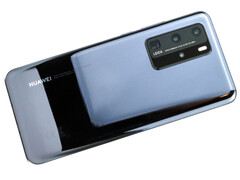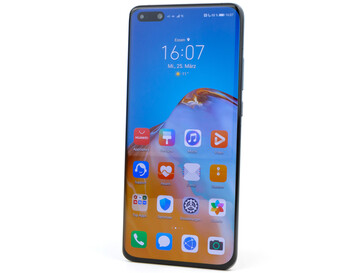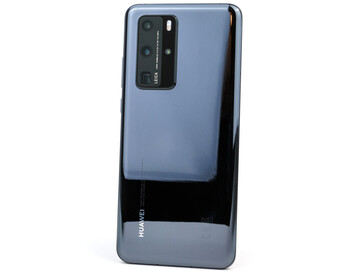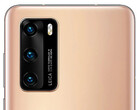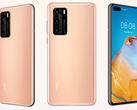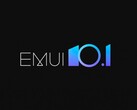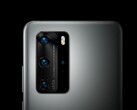The Huawei P40 Pro is indeed a bit smaller than its predecessor, the P30 Pro, but it's also thicker in return. The camera hump has grown visibly and is visually reminiscent of that of the Samsung Galaxy S20 Ultra but is considerably narrower. The smartphone consists again of a combination of metal and glass and leaves a first-class impression in terms of workmanship. Black and silver frost will be the color variants offered to begin with in these parts; a blue version will follow later. The smartphone also has an IP68 rating protecting it against dust and water.
OLED display with FHD+ and 90 Hz
Huawei has equipped the P40 Pro with the most modern technology. It's powered by a Kirin 990 5G, 8 GB of RAM and 256 GB of UFS 3.0 storage. The latter can be expanded by up to a further 256 GB using a Nano Memory card. The so-called overflow display is characterized by the fact that it's not only curved on the sides but also on the top and bottom edges; only the corners aren't curved so that the front glass meets the metal frame in an optically appealingly way at this point. Since the panel curvature is very discreet, readability isn't restricted. The 6.58-inch OLED panel has a resolution of 2640x1200 pixels, which puts it in the Full HD+ category; it's unfortunate that it doesn't offer WQHD+ resolution. At 441 PPI, however, the pixel density is absolutely fine and ensures that the content is displayed sharply. In addition, the Huawei smartphone features a 90 Hz mode. The manufacturer speaks of a very energy-efficient variant here, which should hardly affect battery life. Whether this is true, however, will only be shown in the extensive review.
P40 series with 5G for all
The battery of the Huawei P40 Pro has a capacity of 4,200 mAh, which is the same size as in the P40 Pro Plus. The battery is charged by cable with Huawei's SuperCharge (40 watts), while up to 27 watts can be received by induction, and reverse wireless charging is also available. For mobile radio connections, the potential of the Kirin 990 5G is fully exploited, and this ensures a wide frequency coverage for all mobile phone standards including 5G. There won't be an LTE version; instead, Huawei will equip all new smartphones of the P40 series with the faster 5G chipset. The Chinese have also been hard at work when it comes to WLAN and have configured the P40 Pro with Wi-Fi 6 featuring VHT160, which should achieve up to 2.4 GBit/s in theory. In everyday life, this will probably be almost impossible, but Huawei should still be able to grab the crown for the fastest smartphone in terms of WLAN in its review, since all competitors are using VHT80.
Huawei P40 Pro with large 50 MP sensor
The main camera is the star of the Huawei P40 Pro and has been named "UltraVision Leica Quad Camera". The main sensor (1/1.28") is brand new and is one of the largest ever built into a smartphone; only the Nokia PureView 808 (1/1.2") had a larger sensor area. The sensor features 50 MP, four of which are always combined to form a super pixel. While the pixel size of the P30 Pro was already comparatively large at 1.0 µm, it has now increased to 1.22 µm and is consequently significantly larger than the competition, which promises a good image quality in dark scenarios.
Moreover, the P40 Pro also has the Ultra Wide Cine Lens (40 MP), which we already know from the Mate 30 Pro. This serves as an independent video sensor and is also used for ultra wide-angle shots. A nominal 5x periscope lens (12 MP) is responsible for the zoom, which allows a magnification up to 50x. All three lenses feature optical image stabilization as well as Huawei's AIS. The latter is supposed to have been greatly improved, especially for zooms in videos, and to lock on to the subject, so to speak, to ensure the most stable recording possible. The fourth lens is a ToF camera.
Autofocus for selfies and AI Best Moments
There are two lenses and an IR sensor on the front side. The latter enables the P40 Pro's gesture support and also provides information for face recognition but not at the level of full 3D recognition. The selfie camera has a resolution of 32 MP and now also supports Ultra HD video as well as an autofocus function.
A lot has also changed on the software side too, and AI Best Moments should make it even easier to take good-looking photos. The smartphone's AI analyzes the pictures and removes people from the background, computes reflection removal, determines the optimal shutter release moments and provides a selection of images, among many other features.
Price and availability
The Huawei P40 Pro will be offered at an MSRP of 999 Euros (~$ 1,116), while the smaller P40 will go for 799 Euros (~892). Preorders are possible between March 26 and May 1, 2020. Those who take advantage of this option can receive both a Huawei Watch GT2e and the Huawei FreeBuds 3 free of charge via the preorder promotion. More information can be found on Huawei's website. The P40 and P40 Pro will be available in stores starting May 2, 2020. As has been the case recently, the Huawei P40 Pro will also be delivered without Google services.
Source(s)
Own sources




